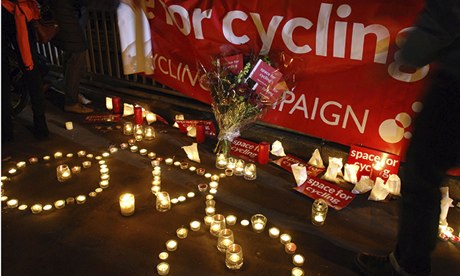
Tributes to a cyclist killed at Bow roundabout, London, on 13 November 2013. Photograph: James Perrin/Rex Features
London has become a cycling city – and Britain something of a cycling nation – by default. The recent surge in its popularity has been a grassroots phenomenon, prompted by overcrowded and expensive public transport, a large number of young, talented people on low wages and a wider recognition of its health and environmental benefits.
As demonstrated by the recent toll of cycling fatalities, the response from the authorities has been slow, inadequate and, in the case of the appalling Cycle Superhighway 2 in east London, counterproductive. There has been no sense of urgency about improving cyclists’ safety. Transport for London’s long-awaited freight strategy to reduce lorry journeys at peak times to avoid conflict with cyclists has not materialised, despite the fact that during the Olympics a very similar scheme was successfully deployed.
While cycling remains relatively safe, TfL’s statistics show that every journey carries a 10% greater risk of resulting in a serious injury or death than in 2008. The Cycling Vision drawn up by Boris Johnson’s cycling tsar, the journalist Andrew Gilligan, is commendable, but lacks both urgency and the coherent thread that would deliver safe cycling for all.
One of London’s rival global cities, New York, is demonstrating what could be done immediately. The city’s transport commissioner, Janette Sadik-Khan, has embarked on a radical plan to improve the lot of pedestrians and cyclists. Times Square, for decades a permanent traffic jam, has been turned into a space so peaceful that the city authorities installed deckchairs in the summer; local businesses have boomed.
Crucially, it’s not just Times Square – 50 spaces in suburban centres have been improved in the same way. All this has been done quickly and experimentally, allowing unsuccessful aspects to be reversed, using principally, as Ms Sadik-Khan put it, “paint and plastic” to reroute traffic and create usable spaces.
This is not, as she emphasises in a brilliant TED talk available online, just about cycling. Creating a city fit for cyclists also ensures it is a better place in which to live and work. The lesson from New York is that things can change and quickly. What is needed is a strong political vision and the boldness to implement it.
Take Seville, often reckoned too hot and cramped for cyclists, which has gone from 2,000 cycle trips per day to 72,000 in seven years, thanks to mayor Alfredo Sánchez Monteseirín’s strategy of building cycle lanes, reducing road space for cars and launching a cycle hire scheme. That answers the naysayers who argue that London is not Amsterdam or its streets are too narrow.
Britain is dependent for its future on attracting bright young people, They are the ones most likely to hop on their bikes and consequently they make up a disproportionate number of these tragedies. They deserve the infrastructure to travel safely, arriving at their destination in one piece, rather than having their lives shattered by a 40-tonne truck or a double-decker bus – and we should recognise it is our duty to safeguard their futures in this way.
Christian Wolmar is a writer and broadcaster specialising in transport and is seeking the Labour nomination for the 2016 London mayoral election
by Bukanscam
YOUR COMMENT
